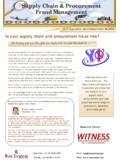Transcription of What You Need to Know About Order-Related …
1 SAP supply chain concepts, technology, and best practices>>continued on page 4 May 2008 Volume 6 | Number 410 Decentralized WMS Serves 24x7 Requirements14 ITSmobile: A New Technology for Warehouse RF Applications20 Globally Restrict Changes to Report Layouts>>insideExamine how Order-Related inter-company billing differs from other types of billing. Understand the special steps required to configure and process Order-Related inter-company billing in SAP You Need to know About Order-Related Inter-Company Billingby Rohana Gunawardena, SAP Practice Director, Quality Software & SystemsImplementing Order-Related inter-company billing can be tricky because no sufficient documentation exists that details several con-figuration nuances. For example, many SAP Notes are helpful but leave out important con-figuration steps. Based on my experience, I ll walk you through everything you need to know About properly configuring this func-tionality in your SAP commonly use transactions VF01, VF04, or batch program SDBILLDL for Order-Related customer billing, delivery- related customer billing, and delivery- related inter-company billing.
2 (For more information About the difference between Order-Related billing and delivery- related billing, refer to the sidebar Order-Related vs. Delivery- related Billing on page 7.) However, you cannot use either of these transactions or the batch program to process Order-Related inter-company billing. Instead, you must use a unique work-around. The alternative method is based on output type RDIV and requires either transaction VF31, batch program SD70AV3A, or batch program RSNAST00, which you typically use to produce printed invoice outputs, not billing ll highlight how to prepare your system to ensure that Order-Related inter-company billing works properly. Then I ll describe the necessary steps to configure it and explain how to print and process Order-Related inter-company billing. Finally, I ll leave you with some tips and tricks I ve discovered through my experience implementing it. Most billing in SAP is delivery related , but you need to use Order-Related billing for some business processes, such as services.
3 Also, you use inter-company billing, for example, in a triangular trade scenario, in which dif-ferent legal entities within an organization are responsible for selling and delivering products. Combining these two types of billing results in Order-Related inter-company billing. Key Concept>> 2008 SCM Expert Reproduction prohibited. All rights Distribution (SD) invoicing, you must configure the relationship between the ref-erence documents ( , orders or deliveries) and the billing document. Billing copy control manages the flow of data from one SD document to another. In my example, the flow of data is from the sales order to the billing document. Run transaction VTFA to configure copy control for billing types IVA and IGA (Figure 3). The screenprint shows IVA, but the process for IGA is similar. In this screen, ensure that all sales order to billing document combinations exist, especially for custom sales order types and item categories. Double-click on the Header folder on the left side of Figure 3 to view the copy action VOFA to create IVA and IGA as a copy of billing types IV and IG.
4 If you make any configuration changes to the standard settings ( , a document pricing procedure, output determination procedure, or text determination procedure), I advise copying IVA to ZIVA and IGA to ZIGA via transaction code VOFA. The matching cancellation billing types are IVS and IGS, which are also used for deliv-ery- related inter-company billing. If you use ZIVA and ZIGA, I suggest copying IVS and IGS to ZIVS and ZIGS, so that you can make the matching configuration changes for the cancellation billing types to mirror the ZIVA and ZIGA billing types. Step 2. Configure billing copy control for billing types IVA and IGA. For Sales Preparing for Order-Related Inter-Company BillingFor Order-Related inter-company billing, SAP developed a special process involv-ing output determination, in which the external customer billing document trig-gers the Order-Related inter-company billing as if it were a printed invoice. SAP Note 63459 outlines the main Order-Related inter-company billing aspects.
5 Figure 1 shows the Order-Related inter-company billing document workflow. The Order-Related inter-company billing is a child of the customer you start the configuration in the next section, refer to the sidebar Critical Updates to SAP Note 63459 on page 8 for a list of key missing details to ease the configuration and support of Order-Related inter-company billing functionality in your SAP environment. Regardless of your SAP release (R/3 or SAP ERP ), you should review the entire configuration and thoroughly test the process because it is easy to miss , make sure you use standard report RVIVAUFT in the configuration to create the Order-Related inter-company billing documents when you process output type RDIV. SAP has replaced the SAPscript driver program with an Order-Related inter-company billing creation program. Consider that you might need to change the standard code in report RVIVAUFT. Billing types IVA and IGA are hard coded in the program, so if you use your own billing types ( , ZIVA and ZIGA), then you must modify the report or create a custom copy.
6 Figure 2 shows the code changes you must use if you have custom billing types. Configuration StepsStep 1. Define billing types IVA and IGA. You can use standard creation billing types IVA and IGA, but your system might not have IVA or IGA defined. Go to trans-Document flow with inter-company Order-Related billingFigure 1 Overview of the header-level copy control configuration via transaction VTFAF igure 3 DATA : LOC_IV_FKARA LIKE KOMFKGN-FKARA,* LOC_FKARA_IVA LIKE KOMFKGN-FKARA VALUE IVA , * LOC_FKARA_IGA LIKE KOMFKGN-FKARA VALUE IGA . LOC_FKARA_IVA LIKE KOMFKGN-FKARA VALUE ZIVA , LOC_FKARA_IGA LIKE KOMFKGN-FKARA VALUE ZIGA . Report RVIVAUFT code changes support custom billing typesFigure 2 May 2008 For group rates on electronic access, call 1-781-751-8799 control configuration details (Figure 4). Be sure to leave the header-level Copying requirements field blank. Order-Related inter-company billing is based on success-ful customer billing, so you do not need to re-check the to the overview screen for trans-action VTFA in Figure 3 and then double-click on the Item folder to view the item-level data (Figure 5).
7 Here you configure item-level copying require-ments. In the Copying requirements field, enter 036, which represents the routine written specifically for Order-Related inter-company billing. Step 3. Determine the Output Type set-tings. Run transaction V/40 to determine the output type settings. In the output details screen that appears, enter standard output type RDIV and ( order -relevant inter-company billing) as shown in Figure 6. Under the General data tab, select Access to con-ditions and CannotBeChanged to allow SAP ERP to use access sequences and prevent the manual entry of RDIV into customer billing documents. Leave the Multiple Issuing option blank to ensure that Order-Related inter-company billing is posted only once. Next, click on the Processing routines folder in the Dialog Structure in Figure 6. In the screen that appears, enter program RVIVAUFT for the Medium (transmission medium) 8 Special function so that SAP ERP calls the processing program (Figure 7). Refer to SAP Note 728993 (Output type RDIV is missing in the standard system) for more click on Partner functions in the Dialog Structure.
8 In the screen that appears, set the partner function (Funct) to PY and the Name to Payer for the trans-mission medium 8 Special function, as shown in Figure 8 (on the next page). This configuration process determines which partner number the system assigns to the output type RDIV in the customer copy control configurationFigure 4 Item-level copy control configurationFigure Output type RDIV general configurationFigure 6 Assign the program RVIVAUFT to the medium 8 Special functionFigure 2008 SCM Expert Reproduction prohibited. All rights 4. Configure the output determina-tion procedure. This procedure is the SAP configuration that selects the output type for an individual billing document. In my example, I want the system to popu-late all customer Order-Related billing documents that have inter-company billing with output type RDIV. Run transaction V/42 to review the stan-dard output determination procedure V10000. You should see Step 40, CTtp (condition type) RDIV, Requiremnt (requirement routine) 18, Co (condition counter) 0, and Description defaulted.
9 If the default configuration does not contain a requirement routine or if you see routine 990, manually change this to 18 ( Order-Related inter-company billing). This requirement checks that Order-Related inter-company billing is required before assigning output type RDIV to a specific customer billing 5. Code the billing user exit USEREXIT_KOMKBV3_FILL. To indicate that inter-company billing is required, you must populate the field KOMKBV3-CROSS_COM. When SAP ERP processes inter-company billing, it checks these parameters to ensure that only customer Order-Related invoices with inter-company billing have output type RDIV populated. Go to the Downloads section of the SCM Expert knowledgebase at to download the code for the user exit. In a nutshell, the logic com-pares the sales organization company code to the plant company code. This comparison determines if inter-company billing is required and if it is Order-Related billing. You might need the help of your technical team for this step.
10 Add the downloaded code in USEREXIT_KOMKBV3_FILL, which populates a cross-company identifier in field KOMKBV3-CROSS_COM. Go to transaction SE38 and insert the code in include RVCOMFZZ. RDIV output condition recordsFigure 9 Assign the output type to a partner functionFigure 8 Step 6. Create the output condition records. After you complete the output determination configuration in the IMG via transaction V/42, you still need to perform another crucial step. You must populate the output condition records for output type RDIV, which SAP considers as master data. RDIV uses the condition tables that are assigned in the access sequence via transaction VV31 to deter-mine which billing documents to populate with the output type default condition table configures the condition type by customer billing type. You do not need to have sophisticated output condition table logic to identify Order-Related inter-company billing transactions because the code you added to USEREXIT_KOMKBV3_FILL is sufficient.


